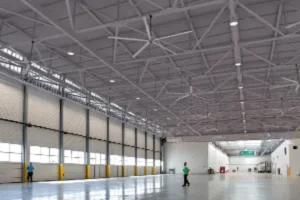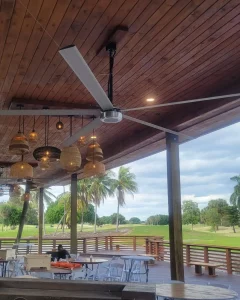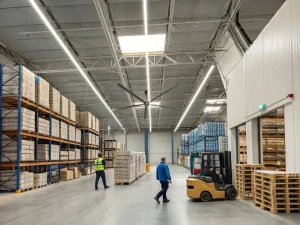Factories, gyms, and warehouses often suffer from stifling heat and poor ventilation. This problem disrupts operations and impacts worker comfort. It can be frustrating and costly. Fortunately, an effective solution exists: installing the right ceiling fan can transform your environment, reduce costs, and elevate overall productivity.
Yes, bigger fans can deliver superior airflow for large spaces, reducing energy consumption while enhancing comfort. A larger fan circulates more air at lower speeds, creating efficient, widespread cooling compared to small fans. From industrial warehouses to commercial buildings, a properly selected ceiling fan can dissipate heat, boost occupant well-being, and lower operating costs.

Large industrial fan in large space
When I say ceiling fan, I’m referring to a mounted fixture designed to move air throughout a room by spinning fan blades. Ceiling fans are essential in commercial, industrial, and residential settings, as they help maintain airflow and temperature control. From our experience at HVLS Fans Manufacturing, these fans provide powerful, cost-efficient solutions for spaces with high ceilings, open-concept areas, and more.
So why does fan size matter? First, the size of the fan blades will determine the amount of air that’s circulated. A larger fan typically moves more air at lower speeds. Conversely, a smaller fan might require a higher rpm (revolutions per minute) to push the same amount. This difference plays a massive role in energy usage, comfort, and performance compared to smaller counterparts. In our quora-inspired research, we found that bigger fans often cover wider areas, making them perfect for larger rooms.
Airflow is the movement of air created by a ceiling fan or ventilation system. For business settings—factories, gyms, schools—proper air circulation ensures a comfortable environment that supports health and productivity. The fan can generate better airflow, creating a wind-chill effect that cools occupants even at moderate fan speed.
At Vindus fans we’ve seen how powerful fans move more air at lower speeds, leading to significant energy savings. When air is in constant motion, it reduces stagnant pockets of heat and moisture buildup. This helps maintain air quality, lowers stress on HVAC systems, and supports a quieter work environment because big fans can operate more quietly than smaller fans.
Commercial and industrial companies are often under pressure to trim energy costs. Electricity bills can skyrocket, especially in hot climates that demand heavy use of air conditioning. Ceiling fans offer an alternative by improving air flow and distributing cool or warm air more evenly, reducing reliance on HVAC units.
In large spaces, big fans with larger blades can move the same amount of air as multiple small fans, while using less energy. This is crucial for factories or distribution centers with high ceilings, where you want to reduce your energy consumption while still maintaining comfort. By installing a large fan, you keep the fan running at lower speeds, lower your carbon footprint, and increase workplace satisfaction. That’s why at Vindus fans , we emphasize energy efficiency as a cornerstone of modern facility design.
Room size is critical when determining your fan selection. For larger areas, you’ll want a larger fan or even larger industrial fans. Meanwhile, smaller rooms might benefit from smaller fan setups or specialized models. To achieve optimal air circulation, you need to match the fan size to your specific room size.
If you’re choosing a ceiling fan for a massive distribution center or manufacturing floor, you should look at larger ceiling fans typically designed for expansive spaces. These fans move more air at lower speeds, ensuring comfort without generating disruptive noise. At HVLS Fans Manufacturing, we notice many open layouts in factories or open-concept spaces can see a dramatic improvement in worker comfort with a single large industrial installation.

large hvls fan in open-concept
Some people wonder if investing in a bigger fan automatically means a higher price tag. While it’s true that big fans can have a larger upfront cost due to their size, the overall fan costs often balance out. A fan may initially appear expensive, but it can be cost-effective in the long run.
Fans work by circulating air efficiently, keeping the environment balanced and reducing strain on climate-control systems. Because they typically operate at lower speeds, they consume less energy over time. For example, a large HVLS fan can push the same amount of air as multiple smaller units combined. This lessens the need for numerous fans, cutting maintenance and replacement expenditures. We’ve seen businesses see the results in their monthly utility bills, operational improvements, and workforce satisfaction.
Reducing energy consumption boils down to selecting the fan size appropriate for your space, employing proper air circulation strategies, and being mindful of fan performance. Always look at rpm and cfm (cubic feet per minute) ratings to gauge how much air is moved with each rotation. Higher rpm doesn’t always mean better or more efficient movement of air—it’s about synergy between fan motor, blade design, and speed of fan.
At HVLS Fans Manufacturing, we encourage clients to use a single large fan rather than multiple smaller units for large floor plans. Our data demonstrates this approach can deliver much airflow while lowering energy use. Additionally, adopting energy star-rated fans that meet standards set by the U.S environmental protection agency helps guarantee energy efficiency compliance.
Different settings—from warehouses and factories to sports centers and commercial buildings—have their own demands. In very large and open-concept spaces, a larger ceiling fans typically arrangement is recommended to move more air at lower speeds. This fosters uniform temperature distribution. For specialized areas like gyms where people sweat heavily, constant air movement can keep humidity at bay.
Our HVLS solutions also help dissipate heat in busy production floors. Creating a wind-chill effect by running the fan in forward mode speeds up evaporation of perspiration. Meanwhile, reversing the direction of your ceiling fan can pull cooler air upwards or push warmer air down, depending on the season, helping your HVAC system function more effectively.

large fan in a warehouse
When you choose a fan that complements your space, it’s vital to balance aesthetics, performance, and utility. A ceiling fan can serve as a focal point in a room, especially if the design resonates with the décor. Also, a large industrial fan in a high-end retail store might be overkill or visually jarring.
For manufacturing facilities, we always propose you choose a fan designed for tough environments. This ensures it’s not only reliable but also built to handle heavy usage. If you want to find the perfect synergy, note these tips:
If the size of the fan blades suits your layout, you’ll have robust cooling without overconsumption.
Yes! A ceiling fan helps maintain fresh and clean air by continuously circulating air, which keeps stagnant pockets from forming. Proper ventilation and continuous airflow are vital to regulating temperature and humidity in large or crowded spaces. By circulating air at lower speeds, a fan is better at distributing hot or cool zones more evenly.
Moreover, by operating an HVLS ceiling fan, you can dissipate heat much faster. In cold seasons, you can reverse the rotation to push warm air down, balancing the temperature near the floor. This approach can yield substantial energy savings because you won’t rely solely on your heating or cooling systems, which typically demand more power.
Here are some guidelines to help you make an informed choice:
At HVLS Fans Manufacturing, we aim to guide you each step of the way, ensuring you move more air at lower power usage, so your facility enjoys a quietly than smaller fans environment that’s both comfortable and efficient.
Below is a quick reference table comparing different fan sizes, typical rpm, and recommended coverage:
| Fan Size | Typical RPM | Coverage Area | Notable Features |
|---|---|---|---|
| 120mm fans | ~2000 – 4000 | PC/CPU cooling | High speed of fan, minimal coverage |
| 140mm fans | ~1800 – 3000 | PC/CPU cooling | Moderate airflow, often quieter than 120mm |
| 200mm | ~1200 – 2000 | Specialty enclosures | Lower noise, bigger blades, more air volume |
| 5-7 ft | ~80 – 120 | Small rooms | General household or office usage |
| 8-10 ft | ~50 – 80 | Medium rooms | Good for typical living rooms |
| 12-24 ft | ~40 – 60 | Large commercial areas | HVLS fans for extensive coverage |
Notice how the 140mm fans and 120mm fans are typically smaller, used in specialized situations like electronics cooling, whereas bigger commercial fans measure in feet for amount of air at lower speeds. Each size has unique benefits.
Below is a simplified text-based chart showing how fan diameter can relate to power draw:
Fan Diameter (ft) | Avg Power Draw (Watts)
------------------|------------------------
8 | 80 - 120
12 | 120 - 180
20 | 180 - 240
24 | 240 - 300
As fan diameter increases, the average power draw is higher, but one larger fan can replace multiple smaller ones, thus potentially reducing total energy usage.
A large industrial warehouse in need of overhead cooling once reached out to Vindus fan. They wanted to reduce fan costs and energy use for better occupant comfort. Initially, they had multiple small fans arranged in corners, but the environment still felt uncomfortably hot.
We installed a single 24 ft HVLS ceiling fan in their open-concept facility. Despite the higher price tag at purchase, they reported lower monthly bills because they could move the same amount of air at lower speeds. They also noted less noise and more uniform temperatures throughout the facility. This exemplifies how bigger is better when it comes to large, open spaces.
“It’s as simple,” the warehouse manager said, “one big fan replaced four small fans and used less electricity overall.”
How do ceiling fans work in winter months?
In colder seasons, you can reverse the rotation to pull cool air upward and push warm air down. This evens out the temperature near floor level. A well-placed ceiling fan can offset heating demands.
Are ceiling fans often noisy or disruptive?
Not necessarily. Many modern ceiling fans operate at lower speeds, using advanced motor designs to run smoothly and with minimal sound. Some even operate more quietly than smaller counterparts, depending on the brand.
Which rooms benefit most from big fans?
Larger rooms or spaces with high ceilings enjoy the most benefit. An HVLS large fan is perfect for a focal point in a room, such as an industrial work area, sports hall, or commercial building.
Can bigger blades reduce my HVAC usage?
Yes, bigger blades typically cover a larger area, helping dissipate heat and augment HVAC performance. Thanks to broad coverage, you can often set your thermostat a bit higher or lower, which translates to energy savings.
Do fans provide enough cooling to skip air conditioning?
While fans help create a wind-chill effect, they don’t actually lower the ambient temperature, so you may still need AC in extremely hot climates. However, they enhance the distribution of cooled air, maximizing the AC’s efficiency.
How does fan speed affect cost?
The speed of fan affects power consumption. Using lower speeds in large spaces helps deliver air at lower overall wattage, saving on energy costs.
At Vindus fan, we’ve worked with factories, commercial buildings, sports centers, gyms, schools, warehouses, and manufacturing facilities for years, delivering robust HVLS solutions. We provide fans recognized under energy star guidelines, which means they meet stringent criteria set by the U.S environmental protection agency. Our extensive track record proves our fans are not only reliable but also exceptionally efficient in distributing airflow.
Ultimately, ceiling fans work as crucial support for climate management in big, open areas. Whether you’re aiming for comfortable office spaces, safer industrial environments, or cooler sports venues, an HVLS fan can help you answer the questions about better cooling solutions. Remember, not every fan is better simply because it’s bigger, but the right sizing and design can significantly enhance efficiency. By analyzing your specific needs, you can choose a fan that complements your layout perfectly—and enjoy the comfort and energy savings that come with it.
Looking to upgrade your facility’s ventilation system or find the perfect ceiling fan? Contact Vindus fan today. We’d love to guide you step by step, ensuring you get the most out of your investment. And don’t forget, we’re offering an exclusive 1000 in bonus equipment discount for select new installations. Questions to see if you qualify? Reach out to us now—separate account allows you to compare different fan setups and see the results firsthand!
Insights based on first-hand experience at Vindus fan , referencing data from Energy Star and recommendations aligned with the environmental protection agency guidelines.

Hi, I’m Michael Danielsson, CEO of Vindus Fans, with over 15 years of experience in the engineering and design industry. I’m here to share what I’ve learned. If you have any questions, feel free to contact me at any time. Let’s grow together!